高中英语语法教案(全套)及配套练习
- 格式:doc
- 大小:280.50 KB
- 文档页数:77
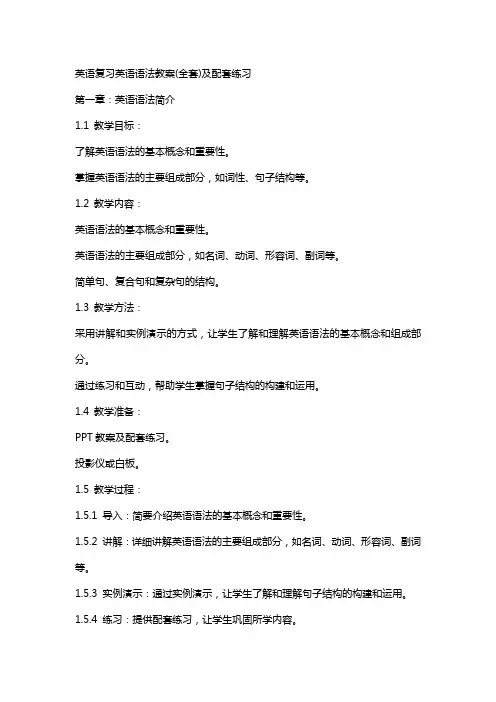
英语复习英语语法教案(全套)及配套练习第一章:英语语法简介1.1 教学目标:了解英语语法的基本概念和重要性。
掌握英语语法的主要组成部分,如词性、句子结构等。
1.2 教学内容:英语语法的基本概念和重要性。
英语语法的主要组成部分,如名词、动词、形容词、副词等。
简单句、复合句和复杂句的结构。
1.3 教学方法:采用讲解和实例演示的方式,让学生了解和理解英语语法的基本概念和组成部分。
通过练习和互动,帮助学生掌握句子结构的构建和运用。
1.4 教学准备:PPT教案及配套练习。
投影仪或白板。
1.5 教学过程:1.5.1 导入:简要介绍英语语法的基本概念和重要性。
1.5.2 讲解:详细讲解英语语法的主要组成部分,如名词、动词、形容词、副词等。
1.5.3 实例演示:通过实例演示,让学生了解和理解句子结构的构建和运用。
1.5.4 练习:提供配套练习,让学生巩固所学内容。
1.5.5 总结:对本节课的内容进行总结,强调重点和难点。
第二章:名词2.1 教学目标:掌握名词的分类和用法。
能够正确使用名词构成句子。
2.2 教学内容:名词的分类,如可数名词、不可数名词、专有名词等。
名词的所有格形式。
名词在句子中的作用和用法。
2.3 教学方法:通过讲解和实例演示,让学生了解和理解名词的分类和用法。
通过练习和互动,帮助学生掌握名词在句子中的作用和用法。
2.4 教学准备:PPT教案及配套练习。
投影仪或白板。
2.5 教学过程:2.5.1 导入:简要介绍名词的分类和用法。
2.5.2 讲解:详细讲解名词的分类,如可数名词、不可数名词、专有名词等。
2.5.3 实例演示:通过实例演示,让学生了解和理解名词的所有格形式。
2.5.4 练习:提供配套练习,让学生巩固所学内容。
2.5.5 总结:对本节课的内容进行总结,强调重点和难点。
第三章:动词3.1 教学目标:掌握动词的分类和用法。
能够正确使用动词构成句子。
3.2 教学内容:动词的分类,如行为动词、状态动词、助动词等。
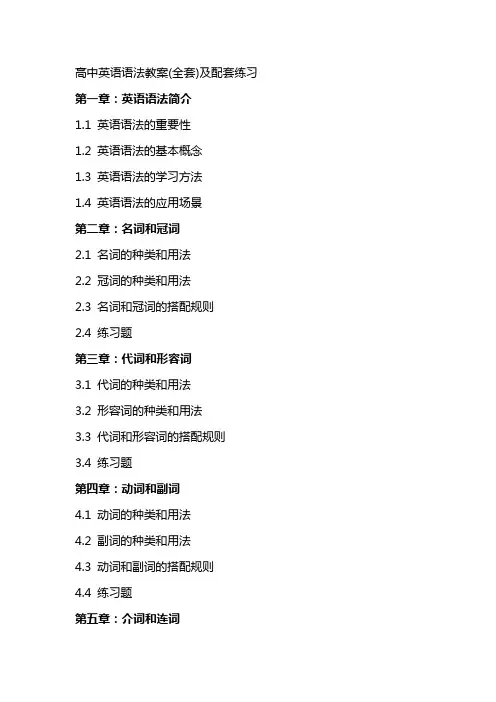
高中英语语法教案(全套)及配套练习第一章:英语语法简介1.1 英语语法的重要性1.2 英语语法的基本概念1.3 英语语法的学习方法1.4 英语语法的应用场景第二章:名词和冠词2.1 名词的种类和用法2.2 冠词的种类和用法2.3 名词和冠词的搭配规则2.4 练习题第三章:代词和形容词3.1 代词的种类和用法3.2 形容词的种类和用法3.3 代词和形容词的搭配规则3.4 练习题第四章:动词和副词4.1 动词的种类和用法4.2 副词的种类和用法4.3 动词和副词的搭配规则4.4 练习题第五章:介词和连词5.1 介词的种类和用法5.2 连词的种类和用法5.3 介词和连词的搭配规则5.4 练习题第六章:句子结构与句子类型6.1 句子结构的基本组成6.2 简单句的类型和用法6.3 复合句的类型和用法6.4 特殊句式的结构和用法6.5 练习题第七章:时态和语态7.1 动词时态的分类和用法7.2 各种时态的构成和用法7.3 被动语态的构成和用法7.4 练习题第八章:情态动词8.1 情态动词的分类和用法8.2 情态动词的辨析8.3 情态动词在不同语境中的使用8.4 练习题第九章:名词从句9.1 名词从句的定义和分类9.2 名词从句的用法和注意事项9.3 练习题第十章:定语从句10.1 定语从句的定义和作用10.2 定语从句的关系词的选择10.3 定语从句的用法和注意事项10.4 练习题第十一章:状语从句11.1 状语从句的类型和用法11.2 状语从句的连接词及其用法11.3 状语从句的注意事项11.4 练习题第十二章:疑问句和否定句12.1 疑问句的类型和用法12.2 否定句的类型和用法12.3 疑问句和否定句的注意事项12.4 练习题第十三章:强调句和倒装句13.1 强调句的构成和用法13.2 倒装句的类型和用法13.3 强调句和倒装句的注意事项13.4 练习题第十四章:虚拟语气14.1 虚拟语气的概念和用法14.2 虚拟语气的形式和变化14.3 虚拟语气的注意事项14.4 练习题第十五章:英语语法的综合练习15.1 综合练习的目的和意义15.2 综合练习的内容和形式15.3 综合练习的答题技巧15.4 练习题重点和难点解析1. 英语语法的重要性:理解语法在英语学习中的作用和重要性,认识到掌握语法对于提高英语水平的关键性。
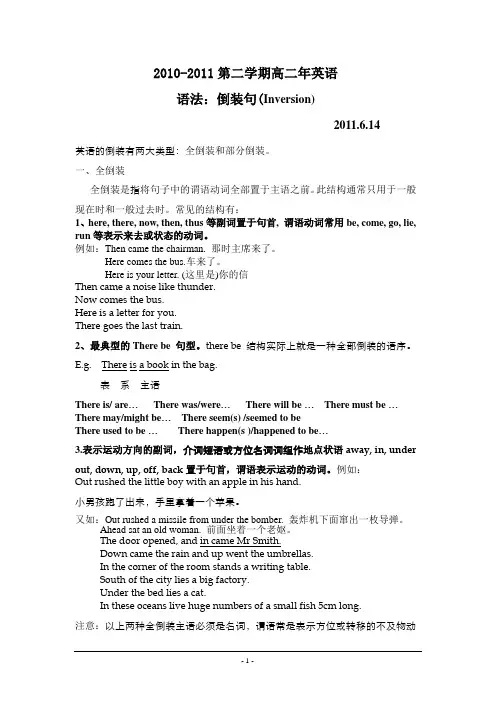
2010-2011第二学期高二年英语语法:倒装句(Inversion)2011.6.14英语的倒装有两大类型:全倒装和部分倒装。
一、全倒装全倒装是指将句子中的谓语动词全部置于主语之前。
此结构通常只用于一般现在时和一般过去时。
常见的结构有:1、here, there, now, then, thus等副词置于句首, 谓语动词常用be, come, go, lie, run等表示来去或状态的动词。
例如:Then came the chairman. 那时主席来了。
Here comes the bus.车来了。
Here is your letter. (这里是)你的信Then came a noise like thunder.Now comes the bus.Here is a letter for you.There goes the last train.2、最典型的There be 句型。
there be 结构实际上就是一种全部倒装的语序。
E.g. There is a book in the bag.表系主语There is/ are…There was/were…There will be …There must be …There may/might be…There seem(s) /seemed to beThere used to be …There happen(s )/happened to be…3.表示运动方向的副词,介词短语或方位名词词组作地点状语away, in, under out, down, up, off, back置于句首,谓语表示运动的动词。
例如:Out rushed the little boy with an apple in his hand.小男孩跑了出来,手里拿着一个苹果。
又如:Out rushed a missile from under the bomber. 轰炸机下面窜出一枚导弹。
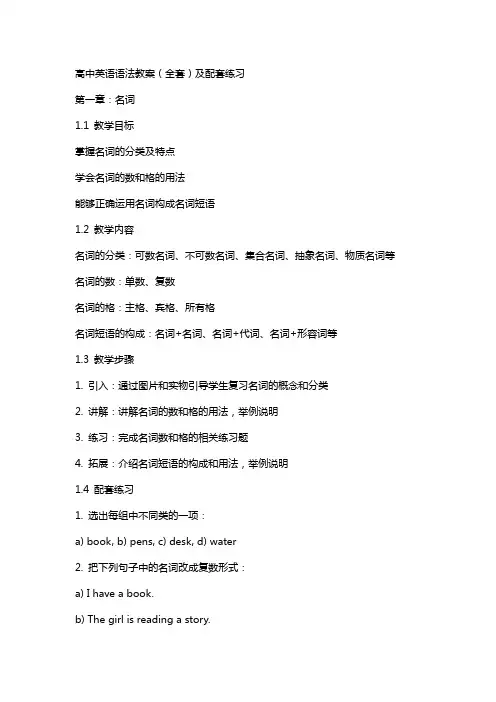
高中英语语法教案(全套)及配套练习第一章:名词1.1 教学目标掌握名词的分类及特点学会名词的数和格的用法能够正确运用名词构成名词短语1.2 教学内容名词的分类:可数名词、不可数名词、集合名词、抽象名词、物质名词等名词的数:单数、复数名词的格:主格、宾格、所有格名词短语的构成:名词+名词、名词+代词、名词+形容词等1.3 教学步骤1. 引入:通过图片和实物引导学生复习名词的概念和分类2. 讲解:讲解名词的数和格的用法,举例说明3. 练习:完成名词数和格的相关练习题4. 拓展:介绍名词短语的构成和用法,举例说明1.4 配套练习1. 选出每组中不同类的一项:a) book, b) pens, c) desk, d) water2. 把下列句子中的名词改成复数形式:a) I have a book.b) The girl is reading a story.第二章:代词2.1 教学目标掌握代词的分类及特点学会代词的用法能够正确运用代词替换名词2.2 教学内容代词的分类:人称代词、物主代词、反身代词、指示代词、疑问代词等代词的用法:主语、宾语、定语、表语等代词的替换:名词替换为代词,代词替换为名词2.3 教学步骤1. 引入:通过图片和实物引导学生复习代词的概念和分类2. 讲解:讲解代词的用法,举例说明3. 练习:完成代词替换的相关练习题4. 拓展:介绍代词的替换规则,举例说明2.4 配套练习1. 完成下列句子,选择适当的人称代词:a) I (1) like (2) .b) Is this (1) book or (2) ?2. 选出每组中不同类的一项:a) they, b) him, c) their, d) this第三章:形容词和副词3.1 教学目标掌握形容词和副词的分类及特点学会形容词和副词的比较级和最高级能够正确运用形容词和副词修饰名词和动词3.2 教学内容形容词和副词的分类:形容词修饰名词,副词修饰动词、形容词、副词等形容词和副词的比较级和最高级:规则变化和不规则变化形容词和副词的用法:前置修饰、后置修饰3.3 教学步骤1. 引入:通过图片和实物引导学生复习形容词和副词的概念和分类2. 讲解:讲解形容词和副词的比较级和最高级的变化规则,举例说明3. 练习:完成形容词和副词比较级和最高级的相关练习题4. 拓展:介绍形容词和副词的前置和后置修饰用法,举例说明3.4 配套练习1. 完成下列句子,选择适当的形容词和副词:a) The (1) sun is (2) today.b) She (1) than her sister.2. 选出每组中不同类的一项:a) tall, b) brighter, c) sunny, d) than第四章:动词4.1 教学目标掌握动词的分类及特点学会动词的时态和语态能够正确运用动词构成句子4.2 教学内容动词的分类:实义动词、助动词、连系动词等动词的时态:一般现在时、一般过去时、一般将来时等动词的语态:主动语态、被动语态4.3 教学步骤1. 引入:通过图片和实物引导学生复习动词的概念和分类2. 讲解:讲解动词的时态和语态,举例说明3. 练习:完成动词时态和语态的相关练习题4. 拓展:介绍动词构成的句子类型,举例说明4.4第四章:动词(续)4.4 配套练习1. 完成下列句子,选择适当的动词形式:a) She (1) a book now.b) The cat (2) the mouse.2. 选出每组中不同类的一项:a) eats, b) walked, c) running, d) is第五章:情态动词5.1 教学目标掌握情态动词的分类及特点学会情态动词的用法能够正确运用情态动词构成句子5.2 教学内容情态动词的分类:can、may、must、shall、will等情态动词的用法:表示能力、可能性、必要性、建议、意愿等情态动词的否定和疑问形式5.3 教学步骤1. 引入:通过情景剧引导学生复习情态动词的概念和分类2. 讲解:讲解情态动词的用法,举例说明3. 练习:完成情态动词的相关练习题4. 拓展:介绍情态动词的否定和疑问形式,举例说明5.4 配套练习1. 完成下列句子,选择适当的情态动词:a) Can (1) swim?b) You (2) finish your work.2. 选出每组中不同类的一项:a) can, b) may, c) must, d) do第六章:冠词6.1 教学目标掌握不定冠词和定冠词的用法学会冠词的省略规则能够正确运用冠词修饰名词6.2 教学内容不定冠词和定冠词的用法:不定冠词用于第一次提到的名词,定冠词用于特指或已知的对象冠词的省略规则:不定冠词的省略、定冠词的省略冠词的用法:单数名词、复数名词、抽象名词等6.3 教学步骤1. 引入:通过图片和实物引导学生复习冠词的概念和分类2. 讲解:讲解不定冠词和定冠词的用法,举例说明3. 练习:完成冠词的相关练习题4. 拓展:介绍冠词的省略规则,举例说明6.4 配套练习1. 完成下列句子,选择适当的不定冠词或定冠词:a) I like (1) apple.b) The (2) sun is shining.2. 选出每组中不同类的一项:a) a, b) the, c) some, d) any第七章:介词7.1 教学目标掌握介词的分类及特点学会介词的用法能够正确运用介词构成短语7.2 教学内容介词的分类:方位介词、时间介词、方式介词、原因介词等介词的用法:表示位置、时间、方式、原因等介词构成的短语:介词+名词、介词+动词等7.3 教学步骤1. 引入:通过图片和实物引导学生复习介词的概念和分类2. 讲解:讲解介词的用法,举例说明3. 练习:完成介词的相关练习题4. 拓展:介绍介词构成的短语,举例说明7.4 配套练习1. 完成下列句子,选择适当的介词:a) The cat (1) under the table.b) I (2) breakfast at 7:00 a.m.2. 选出每组中不同类的一项:a) in, b) on, c) at, d)第八章:句型结构8.1 教学目标掌握简单句、并列句、复合句的结构学会句型的转换能够正确运用句型结构构成句子8.2 教学内容简单句的结构:主语+谓语+宾语并列句的结构:两个或多个简单句用并列连词连接复合句的结构:主句+从句句型的转换:主动句变为被动句、陈述句变为疑问句等8.3 教学步骤1. 引入:通过图片和实物引导学生复习句型结构的概念2. 讲解:讲解简单句、并列句、复合句的结构,举例说明3.重点和难点解析1. 第五章:情态动词的用法情态动词是英语中表达能力、可能性、必要性、建议、意愿等的动词,如can、may、must、shall、will等。
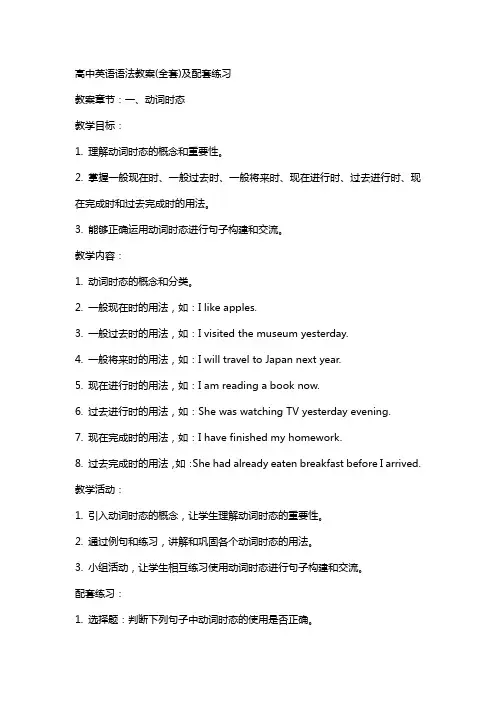
高中英语语法教案(全套)及配套练习教案章节:一、动词时态教学目标:1. 理解动词时态的概念和重要性。
2. 掌握一般现在时、一般过去时、一般将来时、现在进行时、过去进行时、现在完成时和过去完成时的用法。
3. 能够正确运用动词时态进行句子构建和交流。
教学内容:1. 动词时态的概念和分类。
2. 一般现在时的用法,如:I like apples.3. 一般过去时的用法,如:I visited the museum yesterday.4. 一般将来时的用法,如:I will travel to Japan next year.5. 现在进行时的用法,如:I am reading a book now.6. 过去进行时的用法,如:She was watching TV yesterday evening.7. 现在完成时的用法,如:I have finished my homework.8. 过去完成时的用法,如:She had already eaten breakfast before I arrived. 教学活动:1. 引入动词时态的概念,让学生理解动词时态的重要性。
2. 通过例句和练习,讲解和巩固各个动词时态的用法。
3. 小组活动,让学生相互练习使用动词时态进行句子构建和交流。
配套练习:1. 选择题:判断下列句子中动词时态的使用是否正确。
2. 填空题:根据语境,选择合适的动词时态填空。
3. 翻译题:将下列句子翻译成英文,注意使用正确的动词时态。
教案章节:二、名词和冠词教学目标:1. 理解名词的概念和重要性。
2. 掌握可数名词和不可数名词的用法。
3. 掌握定冠词和不定冠词的用法。
4. 能够正确运用名词和冠词进行句子构建和交流。
教学内容:1. 名词的概念和分类。
2. 可数名词和不可数名词的用法,如:apple (可数名词)和water (不可数名词)。
3. 定冠词和不定冠词的用法,如:The cat (定冠词)和a cat (不定冠词)。
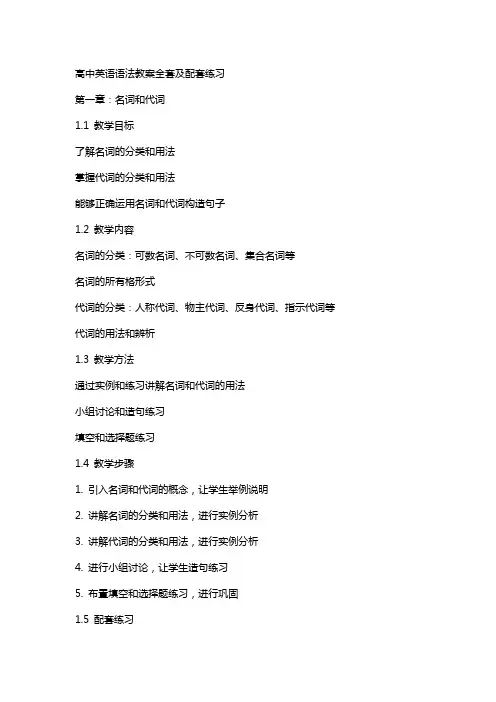
高中英语语法教案全套及配套练习第一章:名词和代词1.1 教学目标了解名词的分类和用法掌握代词的分类和用法能够正确运用名词和代词构造句子1.2 教学内容名词的分类:可数名词、不可数名词、集合名词等名词的所有格形式代词的分类:人称代词、物主代词、反身代词、指示代词等代词的用法和辨析1.3 教学方法通过实例和练习讲解名词和代词的用法小组讨论和造句练习填空和选择题练习1.4 教学步骤1. 引入名词和代词的概念,让学生举例说明2. 讲解名词的分类和用法,进行实例分析3. 讲解代词的分类和用法,进行实例分析4. 进行小组讨论,让学生造句练习5. 布置填空和选择题练习,进行巩固1.5 配套练习名词填空练习代词填空练习名词和代词的选择题练习第二章:动词和形容词2.1 教学目标了解动词和形容词的分类和用法掌握动词和形容词的变形规则能够正确运用动词和形容词构造句子2.2 教学内容动词的分类:行为动词、助动词、情态动词等动词的时态和语态形容词的分类:形容词性、副词性、比较级、最高级等形容词的用法和辨析2.3 教学方法通过实例和练习讲解动词和形容词的用法句子构造练习填空和选择题练习2.4 教学步骤1. 引入动词和形容词的概念,让学生举例说明2. 讲解动词的分类和用法,进行实例分析3. 讲解形容词的分类和用法,进行实例分析4. 进行句子构造练习,让学生运用动词和形容词5. 布置填空和选择题练习,进行巩固2.5 配套练习动词填空练习形容词填空练习动词和形容词的选择题练习第三章:副词和介词3.1 教学目标了解副词和介词的分类和用法掌握副词和介词的辨析能够正确运用副词和介词构造句子3.2 教学内容副词的分类:时间副词、地点副词、程度副词等副词的用法和辨析介词的分类:方位介词、时间介词、关系介词等介词的用法和辨析3.3 教学方法通过实例和练习讲解副词和介词的用法句子构造练习填空和选择题练习3.4 教学步骤1. 引入副词和介词的概念,让学生举例说明2. 讲解副词的分类和用法,进行实例分析3. 讲解介词的分类和用法,进行实例分析4. 进行句子构造练习,让学生运用副词和介词5. 布置填空和选择题练习,进行巩固3.5 配套练习副词填空练习介词填空练习副词和介词的选择题练习第四章:句子结构和时态4.1 教学目标了解句子结构的成分和类型掌握动词的时态和语态能够正确运用句子结构和时态构造句子4.2 教学内容句子的成分:主语、谓语、宾语、定语、状语等句子的类型:陈述句、疑问句、祈使句、感叹句等动词的时态:一般现在时、一般过去时、一般将来时等动词的语态:主动语态、被动语态等4.3 教学方法通过实例和练习讲解句子结构和时态的用法句子构造练习填空和选择题练习4.4 教学步骤1. 引入句子结构和时态的概念,让学生举例说明2. 讲解句子的成分和第五章:条件句和虚拟语气5.1 教学目标理解条件句的类型和用法掌握虚拟语气的构成和用法能够正确运用条件句和虚拟语气构造句子5.2 教学内容条件句的类型:真实条件句、虚拟条件句虚拟语气的构成:过去时、现在时、将来时虚拟语气的用法:愿望、假设、建议等5.3 教学方法通过实例和练习讲解条件句和虚拟语气的用法句子构造练习填空和选择题练习5.4 教学步骤1. 引入条件句和虚拟语气的概念,让学生举例说明2. 讲解条件句的类型和用法,进行实例分析3. 讲解虚拟语气的构成和用法,进行实例分析4. 进行句子构造练习,让学生运用条件句和虚拟语气5. 布置填空和选择题练习,进行巩固5.5 配套练习条件句填空练习虚拟语气填空练习条件句和虚拟语气选择题练习第六章:疑问句和否定句6.1 教学目标掌握疑问句的构成和用法理解否定句的构成和用法能够正确运用疑问句和否定句构造句子6.2 教学内容疑问句的类型:一般疑问句、选择疑问句、特殊疑问句否定句的构成:使用not、never、nowhere等否定词否定句的用法:表示否定、表示惊讶等6.3 教学方法通过实例和练习讲解疑问句和否定句的用法句子构造练习填空和选择题练习6.4 教学步骤1. 引入疑问句和否定句的概念,让学生举例说明2. 讲解疑问句的类型和用法,进行实例分析3. 讲解否定句的构成和用法,进行实例分析4. 进行句子构造练习,让学生运用疑问句和否定句5. 布置填空和选择题练习,进行巩固6.5 配套练习疑问句填空练习否定句填空练习疑问句和否定句选择题练习重点和难点解析1. 第五章中的条件句和虚拟语气:条件句和虚拟语气是英语中较为复杂的语法结构,学生需要理解其类型和用法,这是教学的重点和难点。
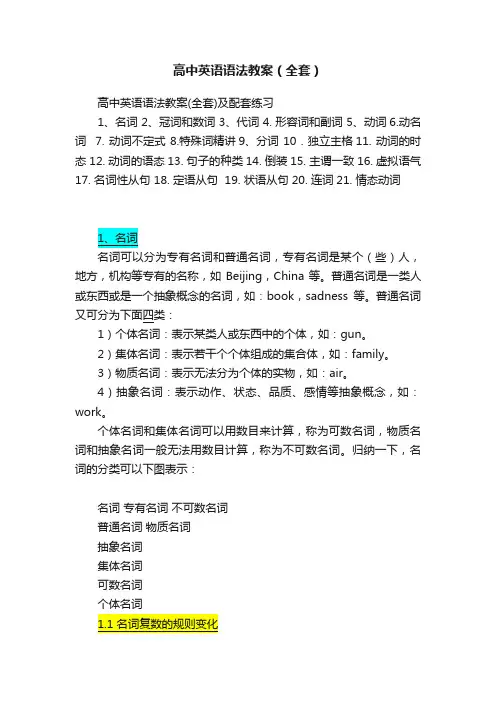
高中英语语法教案(全套)高中英语语法教案(全套)及配套练习1、名词2、冠词和数词3、代词 4. 形容词和副词 5、动词6.动名词 7. 动词不定式 8.特殊词精讲9、分词 10.独立主格11. 动词的时态 12. 动词的语态13. 句子的种类14. 倒装15. 主谓一致16. 虚拟语气17. 名词性从句 18. 定语从句 19. 状语从句20. 连词21. 情态动词名词可以分为专有名词和普通名词,专有名词是某个(些)人,地方,机构等专有的名称,如Beijing,China等。
普通名词是一类人或东西或是一个抽象概念的名词,如:book,sadness等。
普通名词又可分为下面四类:1)个体名词:表示某类人或东西中的个体,如:gun。
2)集体名词:表示若干个个体组成的集合体,如:family。
3)物质名词:表示无法分为个体的实物,如:air。
4)抽象名词:表示动作、状态、品质、感情等抽象概念,如:work。
个体名词和集体名词可以用数目来计算,称为可数名词,物质名词和抽象名词一般无法用数目计算,称为不可数名词。
归纳一下,名词的分类可以下图表示:名词专有名词不可数名词普通名词物质名词抽象名词集体名词可数名词个体名词情况构成方法读音例词一般情况加 -s 清辅音后读/s/ map-maps浊辅音和元音后读 /z/ bag-bags /car-cars以s, sh, ch, x等结尾加 -es 读 /iz/ bus-buses/ watch-watches 以ce, se, ze,等结尾加 -s 读 /iz/ license-licenses以辅音字母+y结尾变y 为i再加es 读 /z/ baby---babies1)以y结尾的专有名词,或元音字母+y 结尾的名词变复数时,直接加s变复数。
如:two Marys the Henrysmonkey---monkeys holiday---holidays2)以o 结尾的名词,变复数时:a. 加s,如: photo---photos piano---pianosradio---radios zoo---zoos;b. 加es,如:potato--potatoes tomato--tomatoesc. 上述a和b两种方法均可,如zero---zeros / zeroes。
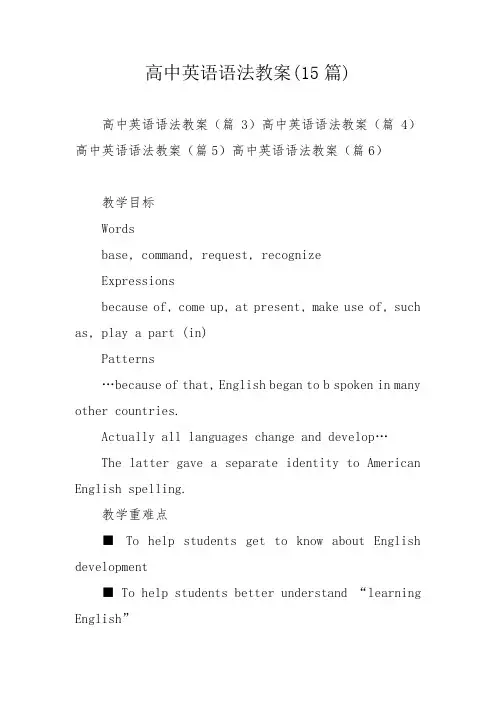
高中英语语法教案(15篇)高中英语语法教案(篇3)高中英语语法教案(篇4)高中英语语法教案(篇5)高中英语语法教案(篇6)教学目标Wordsbase, command, request, recognizeExpressionsbecause of, come up, at present, make use of, such as, play a part (in)Patterns…because of that, English began to b spoken in many other countries.Actually all languages change and develop…The latter gave a separate identity to American English spelling.教学重难点■To help students get to know about English development■ To help students better understand “learning English”■To help students understand and use some important words and expressions■ To help students identify examples of Indirect Speech (II): request commands in the text 教学工具课件教学过程⑴Warming up by listingGood morning, class. We have been learning English for several years. But how many English-speaking countries are there in the world? Now let’s make a list of them on the blackboard.English Countries ExplanationMother tongue the United Kingdomthe United States of AmericaCanadaAustraliaSouth AfricaIrelandNew Zealand The people in these countries are native speakers of English. In total, for more than 375 million people English is their mother tongue.Second language IndiaPakistanNigeriathe Philippines These people speak the language of their own country at home but the language of the government, schools, newspapers, and TV is English. Foreign language ChinaGermanyFranceetc. The number of people who learn English as a foreign language is more than 750 million.⑵Warming up by answering questions about English Good morning, class. Today we shall start learning Unit 2 English around the world. But how much do you know about English?●What is Standard English?Standard English is the form of English that most people in Britain use, and that is not limited to one area or group of people.●What is a dialect?A dialect is a variety of a language spoken only in one area, in which words, or grammar are slightlydifferent from other forms of the same language.●Do we have standard Chinese? What is it?In China there’re so many dialects that the government encourages the whole nation to speak Putonghua, which is regarded as standard Chinese.⑶Warming up by giving reasonsUnit 2 English around the world is what we are going to learn today. We are all learning English now because English is so popular in the world. But do you know why it is so? How many reasons could you giving for the spread of English around the world?English is one of the official languages of the Olympic Games and the United Nations.English dominates international websites and provides nearly all of the new computer terminology. Tourism and trade from Western Europe and North America has contributed to the spread of English.Satellite TV, radio programs like Joy FM, CDs and, of course, Hollywood films all broadcast English into China. Also, a number of Chinese films include English subtitles.2.Pre-readingWe are learning English here. But why are we learning it? Could you suggest to the class as many reasons as you can think of, why people in the world learn English?for work, as a hobby, to learn about other people, to travel, to read literature in the original, to read research papers, to meet foreigners, to surf the Internet, to pass exams, etc.Go on with your reasons. I shall write your suggestions on the board as you make them.3. Skimming the text for general ideasNow we go to page 9 to skim the text for the main idea of each paragraph.Paragraph 1: The spread of the English language in the worldParagraph 2: Native speaker can understand each other even if they don’t speak the same kind of English. Paragraph 3: English changes and develops when cultures meet and communicate with each other.Paragraph 4: By the 19th century English is settled. Paragraph 5: English is spoken as a foreign language or second language in South Asia.4. Reading and fillingRead the text to complete the chart below.Time English is influenced by…AD 450-1150 German1150-1500 FrenchIn the 1600’s Shakespeare, who make use of a wider vocabulary than ever beforeBy the 19th century Samuel Johnson, Noah Webster Now Languages in South Asia, in Singapore, in Malaysia, in Africa and in China5. Reading and copyingNext we shall go over the text once more. This time try find and copy all the useful expressions down in your notebook.Useful expressionsat the end of…, make voyages, speak English as…, in the next century, change over time, communicate with…, be based on…, at present, become less like…, rule England, enrich the English language, make use of…, move to…, later in the 18th century, give a separate identity to…, have a very large number of…, fluent English speakers, become the language for…,develop one’s own identity, increase rapidly.高中英语语法教案(篇7)高中英语阅读课文具有题材广泛、体裁各样、语言学问丰富等特征,是各单元教学的核心部分,也是培育同学阅读力量的主要渠道。
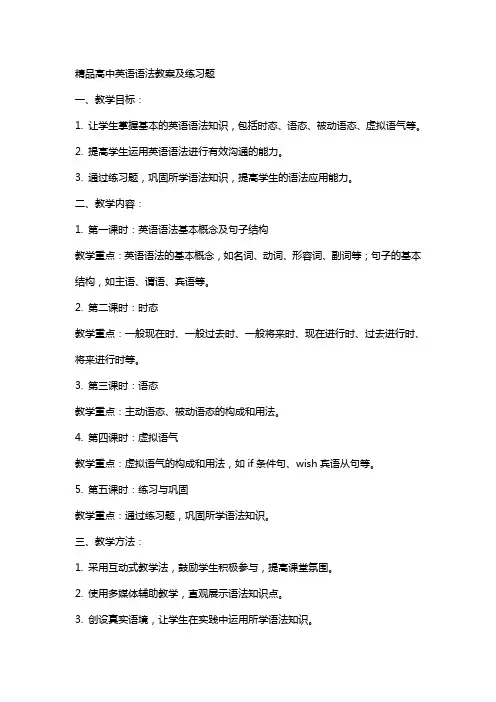
精品高中英语语法教案及练习题一、教学目标:1. 让学生掌握基本的英语语法知识,包括时态、语态、被动语态、虚拟语气等。
2. 提高学生运用英语语法进行有效沟通的能力。
3. 通过练习题,巩固所学语法知识,提高学生的语法应用能力。
二、教学内容:1. 第一课时:英语语法基本概念及句子结构教学重点:英语语法的基本概念,如名词、动词、形容词、副词等;句子的基本结构,如主语、谓语、宾语等。
2. 第二课时:时态教学重点:一般现在时、一般过去时、一般将来时、现在进行时、过去进行时、将来进行时等。
3. 第三课时:语态教学重点:主动语态、被动语态的构成和用法。
4. 第四课时:虚拟语气教学重点:虚拟语气的构成和用法,如if条件句、wish宾语从句等。
5. 第五课时:练习与巩固教学重点:通过练习题,巩固所学语法知识。
三、教学方法:1. 采用互动式教学法,鼓励学生积极参与,提高课堂氛围。
2. 使用多媒体辅助教学,直观展示语法知识点。
3. 创设真实语境,让学生在实践中运用所学语法知识。
4. 针对不同学生,给予个性化指导,提高学生的语法水平。
四、教学步骤:1. 引入新课,介绍本节课要学习的语法知识点。
2. 讲解语法规则,并通过例句演示。
3. 让学生进行小组讨论,互相交流所学知识。
4. 布置练习题,让学生巩固所学语法知识。
5. 讲解练习题,纠正学生的错误,并进行点评。
五、课后作业:1. 完成课后练习题,巩固所学语法知识。
2. 结合所学语法知识,编写一段短文,展示自己的语法应用能力。
3. 预习下一节课的内容,为课堂学习做好准备。
六、教学内容:6. 第六课时:情态动词教学重点:情态动词的用法,如can, may, must, should等。
7. 第七课时:介词和介词短语教学重点:常见介词的用法和搭配,如地点、时间、方向等介词短语。
8. 第八课时:从句教学重点:宾语从句、定语从句、状语从句的用法和连接词。
9. 第九课时:句子结构分析教学重点:主谓一致、倒装句、强调句等特殊句式。
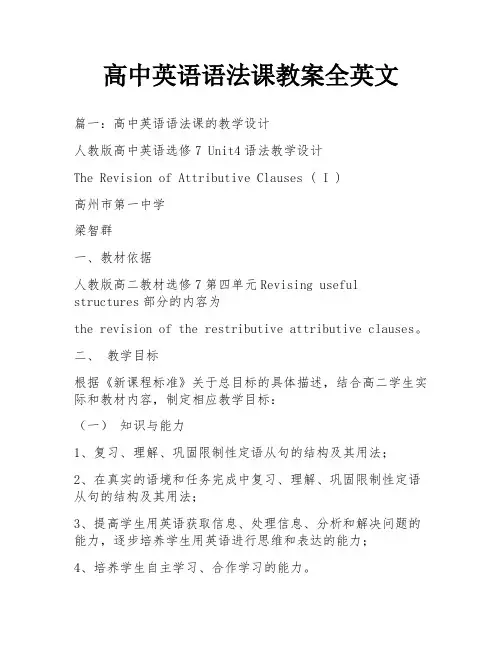
高中英语语法课教案全英文篇一:高中英语语法课的教学设计人教版高中英语选修7 Unit4语法教学设计The Revision of Attributive Clauses ( I )高州市第一中学梁智群一、教材依据人教版高二教材选修7第四单元Revising useful structures部分的内容为the revision of the restributive attributive clauses。
二、教学目标根据《新课程标准》关于总目标的具体描述,结合高二学生实际和教材内容,制定相应教学目标:(一)知识与能力1、复习、理解、巩固限制性定语从句的结构及其用法;2、在真实的语境和任务完成中复习、理解、巩固限制性定语从句的结构及其用法;3、提高学生用英语获取信息、处理信息、分析和解决问题的能力,逐步培养学生用英语进行思维和表达的能力;4、培养学生自主学习、合作学习的能力。
(二)过程与方法1、采用“任务型”语言教学。
根据不同的语法内容设计不同的任务,让学生通过完成任务,在语言运用中去学习、掌握语言形式和语言规则,使学生在做中学,在做中练,在做中巩固。
2、利用真实的环境或设计模拟的情境进行语法教学,使语法教学更趋形象化、直观化、真实化和趣味化。
情景活动中的学习降低了语法学习的难度,激发了学生学习英语的积极性,使他们学得快,记得牢,用得活。
3、把某些语法教学转化为交际活动,具体设计有:(1)英文歌式通过画出英文歌中的restributive attributive clauses,使教学内容生动形象,不仅调动学生的学习兴趣,而且营造良好的课堂氛围。
(2)游戏式根据教学内容设计“接龙”游戏及猜谜游戏。
在这样的操练活动中,学生既锻炼了思维能力与快速反应能力,又加深了对所学语法现象的理解,同时使语法教学既轻松又有效。
(3)讨论式设计一些练习,让学生与同桌或小组同学相互讨论学习,激发学生学习的兴趣,增强学生对英语语言信息的使用和接受能力。
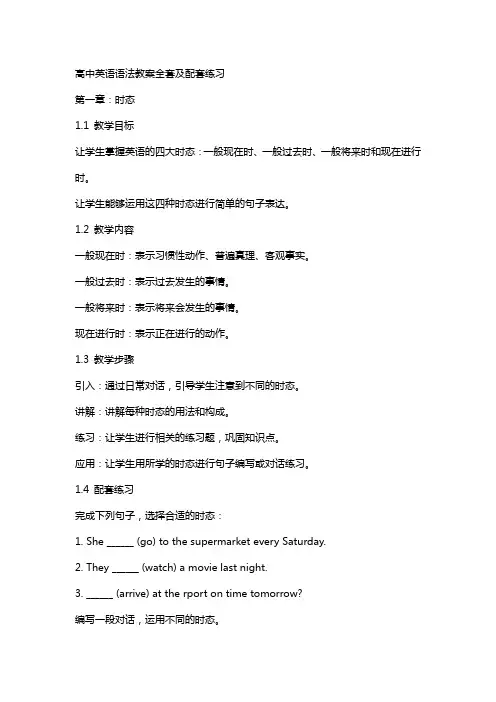
高中英语语法教案全套及配套练习第一章:时态1.1 教学目标让学生掌握英语的四大时态:一般现在时、一般过去时、一般将来时和现在进行时。
让学生能够运用这四种时态进行简单的句子表达。
1.2 教学内容一般现在时:表示习惯性动作、普遍真理、客观事实。
一般过去时:表示过去发生的事情。
一般将来时:表示将来会发生的事情。
现在进行时:表示正在进行的动作。
1.3 教学步骤引入:通过日常对话,引导学生注意到不同的时态。
讲解:讲解每种时态的用法和构成。
练习:让学生进行相关的练习题,巩固知识点。
应用:让学生用所学的时态进行句子编写或对话练习。
1.4 配套练习完成下列句子,选择合适的时态:1. She ______ (go) to the supermarket every Saturday.2. They ______ (watch) a movie last night.3. ______ (arrive) at the rport on time tomorrow?编写一段对话,运用不同的时态。
第二章:被动语态2.1 教学目标让学生掌握被动语态的构成和用法。
让学生能够正确运用被动语态进行句子表达。
2.2 教学内容被动语态的构成:be + 过去分词被动语态的用法:表示动作的承受者。
2.3 教学步骤引入:通过日常对话,引导学生注意到被动语态的存在。
讲解:讲解被动语态的构成和用法。
练习:让学生进行相关的练习题,巩固知识点。
应用:让学生用所学的被动语态进行句子编写或对话练习。
2.4 配套练习完成下列句子,使用被动语态:1. A book ______ (read) someone.2. The window ______ (break) the ball.3. ______ (eat) the cat?编写一段对话,运用被动语态。
第三章:情态动词3.1 教学目标让学生掌握常见的情态动词:can、may、must、should、will。
高中英语语法教案一、教学目标1. 知识目标:(1)掌握五种基本句型结构。
(2)学会使用常用的情态动词。
(3)了解时态的分类和用法。
2. 能力目标:(1)能够运用基本句型进行日常交流。
(2)能够正确使用情态动词表达可能性。
(3)能够根据情境选择合适的时态。
3. 情感目标:激发学生学习英语语法的兴趣,提高自信心。
二、教学内容1. 第一课时:五种基本句型结构(1)主谓结构:S + V(2)主谓宾结构:S + V + O(3)主谓宾补结构:S + V + O + C (4)主谓宾状结构:S + V + O + P (5)主系表结构:S + V + S2. 第二课时:情态动词(1)can(2)may(3)must(4)shall(5)will3. 第三课时:时态(1)一般现在时(2)一般过去时(3)一般将来时(4)现在进行时(5)过去进行时(6)现在完成时(7)过去完成时(8)现在完成进行时三、教学方法1. 情境教学法:通过设定各种真实情境,让学生在实际语境中学习语法。
2. 任务型教学法:设计各种任务,让学生在完成任务的过程中运用语法知识。
3. 互动教学法:鼓励学生积极参与课堂活动,进行同伴交流和合作。
四、教学步骤1. 第一课时:(1)介绍五种基本句型结构。
(2)用例句展示每种句型的用法。
(3)让学生练习造句,巩固所学内容。
2. 第二课时:(1)介绍情态动词的用法。
(2)用例句展示每种情态动词的用法。
(3)让学生进行情景对话,运用情态动词。
3. 第三课时:(1)介绍时态的分类和用法。
(2)用例句展示每种时态的用法。
(3)让学生进行时间顺序排列练习,巩固时态知识。
五、作业布置1. 课后练习:用五种基本句型结构造句。
2. 课后任务:用情态动词完成一个情景对话。
3. 课后作业:选择一个话题,用所学生过的时态编写一个小故事。
六、教学评价1. 平时成绩:观察学生在课堂上的参与程度、回答问题的准确性以及作业完成情况,给予相应的平时成绩。
1.英语:高中英语语法教案(全套)及配套练习2完4. 形容词和副词4.1 形容词及其用法形容词修饰名词,说明事物或人的性质或特征。
通常,可将形容词分成性质形容词和叙述形容词两类,其位置不一定都放在名词前面。
1)直接说明事物的性质或特征的形容词是性质形容词,它有级的变化,可以用程度副词修饰,在句中可作定语、表语和补语。
例如:hot。
2)叙述形容词只能作表语,所以又称为表语形容词。
这类形容词没有级的变化,也不可用程度副词修饰。
大多数以a开头的形容词都属于这一类。
例如:afraid 害怕的。
(错)He is an ill man.(对)The man is ill.(错)She is an afraid girl.(对)The girl is afraid.这类词还有: well,unwell,ill,faint,afraid,alike,alive,alone,asleep,awake 等。
3)形容词作定语修饰名词时,要放在名词的前边。
但是如果形容词修饰以-thing为字尾的词语时,要放在这些词之后。
例如:something nice.4.2 以-ly结尾的形容词1)大部分形容词加-ly可构成副词。
但friendly,deadly,lovely,lonely,likely,lively,ugly,brotherly,仍为形容词。
改错:(错) She sang lovely.(错) He spoke to me very friendly.(对) Her singing was lovely.(对) He spoke to me in a very friendly way.2)有些以-ly 结尾既为形容词,也为副词,如daily,weekly,monthly,yearly,early等。
例如: The Times is a weekly paper. 《时代周刊》为周刊。
The Times is published weekly. 《时代周刊》每周发行一期。
高中英语语法教案(全套)及配套练习一、教案简介本教案旨在帮助高中生系统掌握英语语法知识,提高他们的语法运用能力。
通过本教案的学习,学生将能够熟练运用各类语法知识,提高英语写作和口语表达能力。
二、教学目标1. 掌握基本的英语语法规则;2. 能够正确运用各类语法知识进行句子构建;3. 提高英语写作和口语表达能力;4. 培养学生的自主学习能力和合作精神。
三、教学内容1. 动词时态:一般现在时、一般过去时、一般将来时、现在进行时、过去进行时、将来进行时、现在完成时、过去完成时、将来完成时;2. 被动语态:一般现在时被动语态、一般过去时被动语态、一般将来时被动语态、现在进行时被动语态、过去进行时被动语态、将来进行时被动语态、现在完成时被动语态、过去完成时被动语态、将来完成时被动语态;3. 情态动词:can、may、must、shall、will、would、should、have to、need to;4. 句子结构:主谓宾结构、主谓表结构、主谓宾补结构、主谓宾状结构;5. 定语从句、状语从句、宾语从句。
四、教学方法1. 实例讲解:通过具体例句讲解语法知识,让学生直观地理解并掌握;2. 练习巩固:布置相应的练习题,让学生在实践中运用所学知识;3. 小组讨论:分组讨论,培养学生的合作精神和沟通能力;4. 课堂互动:鼓励学生提问、回答问题,提高学生的参与度和积极性。
五、教学评价1. 定期进行语法测试,检验学生掌握程度;2. 观察学生在课堂上的表现,了解他们的学习进度;3. 收集学生作业,评估他们的语法运用能力;4. 鼓励学生进行自我评价,提高他们的自主学习能力。
六、教学资源1. 教材:《新编高中英语语法教程》2. 辅助材料:PPT、教案、练习题、测试题、视频教程等3. 网络资源:在线英语语法学习网站、英语学习论坛、英语学习APP等七、教学进度安排1. 课时:每个章节安排2-3课时,共10课时;2. 授课方式:讲授、练习、讨论相结合;3. 课后作业:每节课布置相应练习题,要求学生课后完成;4. 语法测试:每个章节结束后进行一次语法测试,共5次。
高中英语语法教案(5篇)高中英语语法教案篇一一、教材分析(一)教材的地位和作用本节课是本单元以及本教材的第一节课,本课谈论的是:朋友是不是仅限于人类、朋友的真正含义、如何与人相处的问题等关于朋友的话题。
本课涉及的有陈述句和疑问句的直接引语和间接引语的掌握和运用等语法要点。
学生从初中到高中,来到一个新的学校,同学彼此陌生,不免想起老同学,老朋友。
这样的话题正好能引起学生的兴趣。
而且本课的内容和语法的启发性和实用性都很强,能使学生在学中用,在用中学,对综合提高学生的听说读写能力有较好的促进作用。
(二)教学目标英语教学大纲规定,通过听说读写的训练,使学生获得英语基础知识和运用英语的能力,激发学生的学习兴趣,为进一步学习打下良好的基础。
因此,我制定以下教学目标:知识目标:1、掌握和使用陈述句和疑问句的直接引语和间接引语。
2、讨论朋友和友谊。
3、学习掌握本课的重点词汇。
技能目标:1、学会阅读的技能——scanningand skimming 。
2、通过谈论朋友和友谊,既锻炼学生的语言运用能力,又培养了学生发现问题、思考问题、解决问题的能力。
3、理解阅读文段,复述故事。
情感态度:1、患难之交才是真朋友。
2、知音难得。
3、海内存知己,天涯若比邻。
文化意识:认识德国的纳粹党。
让学生了解那段德国法西斯残害犹太人的历史,使学生在感受外国历史文化的同时自然而然的习得语言。
(三)重点与难点重点:1、训练scanningand skimming等阅读技能。
2、认识朋友的真正含义以及与人相处的问题。
难点:1、阅读技能的训练。
2、陈述句和疑问句的直接引语和间接引语的互相转换(人称的变化、时态的变化、指示代词、时间状语、地点状语和动词的变化)。
(四)教具本课利用录音机、投影仪等辅助设备,激发学生的学习兴趣,调动他们的积极性,为展开话题提供丰富的材料,使教学收到事半功倍的效果。
二、教法分析在新课程背景下,教师要成为学生学习的促进者、组织者和合作者。
教学目标:1. 让学生理解现在完成时态的构成和用法。
2. 培养学生运用现在完成时态进行日常交流的能力。
3. 提高学生的语法意识和语言表达能力。
教学对象:高中一年级学生教学时间:2课时教学准备:1. 教材:《高中英语》2. 教学课件3. 练习题教学过程:第一课时一、导入1. 教师通过提问,引导学生回顾过去时态的用法。
2. 引出现在完成时态,并简要介绍其构成和用法。
二、讲解1. 现在完成时态的构成:主语 + have/has + 过去分词2. 现在完成时态的用法:a. 表示过去发生的动作对现在造成的影响或结果。
b. 表示过去发生的动作一直持续到现在,并且可能还会继续下去。
c. 表示过去发生的动作与现在有关联。
三、练习1. 教师带领学生进行练习,巩固现在完成时态的用法。
2. 学生分小组进行讨论,互相纠正错误。
四、课堂小结1. 教师总结现在完成时态的构成和用法。
2. 强调现在完成时态在句子中的重要作用。
第二课时一、复习1. 教师通过提问,复习现在完成时态的构成和用法。
2. 学生进行口语练习,运用现在完成时态进行日常交流。
二、拓展1. 教师引导学生思考现在完成时态在不同语境中的运用。
2. 学生进行角色扮演,模拟实际生活场景,运用现在完成时态进行对话。
三、练习1. 教师布置课后练习,巩固学生对现在完成时态的掌握。
2. 学生完成练习,教师批改并讲解。
四、课堂小结1. 教师总结本节课的学习内容,强调现在完成时态的重要性。
2. 鼓励学生在日常生活中多运用现在完成时态,提高英语水平。
教学评价:1. 学生在课堂上的参与度。
2. 学生对现在完成时态的掌握程度。
3. 学生在课后练习中的表现。
教学反思:1. 教师在教学过程中要注意引导学生理解现在完成时态的用法,避免死记硬背。
2. 结合实际生活场景,提高学生对现在完成时态的运用能力。
3. 关注学生的学习进度,及时调整教学策略,确保教学效果。
用来表示主语继续或保持一种状况或态度,主要有keep, rest, remain, stay, lie, stand。
例如:He always kept silent at meeting.他开会时总保持沉默。
This matter rests a mystery.此事仍是一个谜。
3)表像系动词用来表示\"看起来像\"这一概念,主要有seem, appear, look。
例如:He looks tired.他看起来很累。
He seems (to be)very sad.他看起来很伤心。
4)感官系动词感官系动词主要有feel, smell, sound, taste。
例如:This kind of cloth feels very soft.这种布手感很软。
This flower smells very sweet. 这朵花闻起来很香。
5)变化系动词这些系动词表示主语变成什么样,变化系动词主要有become, grow, turn, fall, get, go, come, run。
例如:He became mad after that.自那之后,他疯了。
She grew rich within a short time.她没多长时间就富了。
6)终止系动词表示主语已终止动作,主要有prove, turn out, 表达\"证实\",\"变成\"之意。
例如:The rumor proved false.这谣言证实有假。
The search proved difficult.搜查证实很难。
His plan turned out a success.他的计划终于成功了。
(turn out表终止性结果)5.2 助动词1)协助主要动词构成谓语动词的词叫助动词。
被协助的动词称作主要动词。
助动词自身没有词义,不可单独使用。
例如:He doesn\'t like English.他不喜欢英语。
高中英语语法教案(全套)及配套练习1、名词2、冠词和数词3、代词 4. 形容词和副词 5、动词6.动名词 7. 动词不定式 8.特殊词精讲9、分词 10.独立主格11. 动词的时态 12. 动词的语态13. 句子的种类14. 倒装15. 主谓一致16. 虚拟语气 17. 名词性从句 18. 定语从句 19. 状语从句20. 连词21. 情态动词名词可以分为专有名词和普通名词,专有名词是某个(些)人,地方,机构等专有的名称,如Beijing,China等。
普通名词是一类人或东西或是一个抽象概念的名词,如:book,sadness 等。
普通名词又可分为下面四类:1)个体名词:表示某类人或东西中的个体,如:gun。
2)集体名词:表示若干个个体组成的集合体,如:family。
3)物质名词:表示无法分为个体的实物,如:air。
4)抽象名词:表示动作、状态、品质、感情等抽象概念,如:work。
个体名词和集体名词可以用数目来计算,称为可数名词,物质名词和抽象名词一般无法用数目计算,称为不可数名词。
归纳一下,名词的分类可以下图表示:名词专有名词不可数名词普通名词物质名词抽象名词集体名词可数名词个体名词情况构成方法读音例词一般情况加 -s 清辅音后读/s/ map-maps浊辅音和元音后读 /z/ bag-bags /car-cars以s, sh, ch, x等结尾加 -es 读 /iz/ bus-buses/ watch-watches以ce, se, ze,等结尾加 -s 读 /iz/ license-licenses以辅音字母+y结尾变y 为i再加es 读 /z/ baby---babies1)以y结尾的专有名词,或元音字母+y 结尾的名词变复数时,直接加s变复数。
如:two Marys the Henrysmonkey---monkeys holiday---holidays2)以o 结尾的名词,变复数时:a. 加s,如: photo---photos piano---pianosradio---radios zoo---zoos;b. 加es,如:potato--potatoes tomato--tomatoesc. 上述a和b两种方法均可,如zero---zeros / zeroes。
3)以f或fe 结尾的名词变复数时:a. 加s,如: belief---beliefs roof---roofssafe---safes gulf---gulfs;b. 去f,fe 加ves,如:half---halvesknife---knives leaf---leaves wolf---wolveswife---wives life---lives thief---thieves;c. 上述a和b两种方法均可,如handkerchief: handkerchiefs / handkerchieves。
1) child---children foot---feet tooth---teethmouse---mice man---men woman---women注意:由一个词加 man 或 woman构成的合成词,其复数形式也是 -men 和-women,如an Englishman,two Englishmen。
但German不是合成词,故复数形式为Germans;Bowman是姓,其复数是the Bowmans。
2)单复同形,如deer,sheep,fish,Chinese,Japanese ,li,jin,yuan,two li,three mu,four jin但除人民币的元、角、分外,美元、英镑、法郎等都有复数形式。
如:a dollar, two dollars; a meter, two meters。
3)集体名词,以单数形式出现,但实为复数。
例如:people police cattle 等本身就是复数,不能说 a people,a police,a cattle,但可以说a person,a policeman,a head of cattle, the English,the British,the French,the Chinese,the Japanese,the Swiss 等名词,表示国民总称时,作复数用,如The Chinese are industries and brave. 中国人民是勤劳勇敢的。
4)以s结尾,仍为单数的名a. maths,politics,physics等学科名词,一般是不可数名词,为单数。
b. news 为不可数名词。
c. the United States,the United Nations 应视为单数。
The United Nations was organized in 1945. 联合国是1945年组建起来的。
d. 以复数形式出现的书名,剧名,报纸,杂志名,也可视为单数。
例如:\"The Arabian Nights\" is a very interesting story-book. 《一千零一夜》是一本非常有趣的故事书。
5)表示由两部分构成的东西,如:glasses (眼镜)trousers, clothes等,若表达具体数目,要借助数量词 pair(对,双); suit(套); a pair of glasses; two pairs of trousers等。
6)另外还有一些名词,其复数形式有时可表示特别意思,如:goods货物,waters水域,1)物质名词a. 当物质名词转化为个体名词时为可数。
比较:Cake is a kind of food. 蛋糕是一种食物。
(不可数)These cakes are sweet. 这些蛋糕很好吃。
(可数)b. 当物质名词表示该物质的种类时,可数。
例如:This factory produces steel. (不可数)We need various steels. (可数)c. 当物质名词表示份数时,可数。
例如:Our country is famous for tea. 我国因茶叶而闻名。
Two teas, please. 请来两杯茶。
2)抽象名词表示具体的事例时也可数。
例如:four freedoms 四大自由 the four modernizations四个现代化物质名词和抽象名词可以借助单位词表一定的数量,如a glass of water 一杯水/ a piece of advice 一则建议。
名词作定语一般用单数,但也有以下例外。
1) 用复数作定语。
例如:sports meeting 运动会 students reading-room 学生阅览室talks table 谈判桌 the foreign languages department 外语系2) man, woman, gentleman等作定语时,其单复数以所修饰的名词的单复数而定。
例如: men workers women teachers gentlemen officials3)有些原有s结尾的名词,作定语时,s保留。
例如:goods train (货车) arms produce 武器生产customs papers 海关文件 clothes brush 衣刷4)数词+名词作定语时,这个名词一般保留单数形式。
例如:two-dozen eggs 两打鸡蛋 a ten-mile walk 十英里路two-hundred trees 两百棵树 a five-year plan. 一个五年计划国籍总称(谓语用复数)单数复数中国人 the Chinese a Chinese two Chinese瑞士人 the Swiss a Swiss two Swiss澳大利亚人 the Australians an Australian two Australians俄国人 the Russians a Russian two Russians意大利人 the Italians an Italian two Italians希腊人 the Greek a Greek two Greeks法国人 the French a Frenchman two Frenchmen日本人 the Japanese a Japanese two Japanese美国人 the Americans an American two Americans印度人 the Indians an Indian two Indians加拿大人 the Canadians a Canadian two Canadians德国人 the Germans a Germans two Germans英国人 the English an Englishman two Englishmen英语中有些名词可以加\"\'s\"来表示所有关系,带这种词尾的名词形式称为该名词的所有格,如:a teacher\'s book。
名词所有格的规则如下:1)单数名词词尾加\"\'s\",复数名词词尾没有s,也要加\"\'s\",如the boy\'s bag 男孩的书包,men\'s room 男厕所。
2)若名词已有复数词尾-s ,只加\" \' \",如:the workers\' struggle 工人的斗争。
3)凡不能加\"\'s\"的名词,都可以用\"名词+of +名词\"的结构来表示所有关系,如:the title of the song 歌的名字。
4)在表示店铺或教堂的名字或某人的家时,名词所有格的后面常常不出现它所修饰的名词,如:the barber\'s 理发店。
5)如果两个名词并列,并且分别有\'s,则表示\"分别有\";只有一个\'s,则表示\'共有\'。
例如:John\'s and Mary\'s rooms(两间)John and Mary\'s room(一间)6)复合名词或短语,\'s 加在最后一个词的词尾。
例如:a month or two\'s absence 2.冠词本身不能单独使用,也没有词义,它用在名词的前面,帮助指明名词的含义。
英语中的冠词有三种,一种是定冠词,另一种是不定冠词,还有一种是零冠词。